Light Distribution and Perceived Spaciousness: Light Patterns in Scale Models
Abstract
:1. Introduction
1.1. Important Concepts of Light and Space
1.2. Related Research
2. Materials and Methods
2.1. Methodological Choice and Approach
2.2. Experimental Setup
2.3. Procedure
3. Results
3.1. The Play of Contrasts Affects How the Level of Light and Space Size Are Perceived
3.2. The Effect of Emphasizing Light Patterns
3.3. The Relationship between Size of Illuminated Areas and Spaciousness
3.4. Compound Illuminated Areas Increase Depth and Width
3.5. Separate Illuminated Areas Seem to Increase Space Size
3.6. Interplay of Width, Height and Depth
3.7. Patterns Composed by Light or Luminaires—For a Tangible, Clearly Defined Space
3.8. Perceiving the Shape of a Space: Deformation Effect Related to Shadows
4. Discussion
4.1. Discussion of Results
4.2. Method Discussion
5. Conclusions
Author Contributions
Funding
Institutional Review Board Statement
Informed Consent Statement
Data Availability Statement
Acknowledgments
Conflicts of Interest
References
- Schielke, T. Tutorial: Rationale, Concepts, and Techniques for Lighting Vertical Surfaces. Leukos 2013, 9, 223–243. [Google Scholar] [CrossRef]
- Davoudian, N. Wayfinding and the Hierarchy of Urban Elements at Night. In Urban Lighting for People: Evidence-Based Lighting Design for the Built Environment; Routledge: Abingdon-on-Thames, UK, 2019. [Google Scholar]
- Lynch, K. The Image of the City; The M.I.T. Press: Cambridge, MA, USA, 1960. [Google Scholar]
- Okken, V.; van Rompay, T.; Ad, P. When the World Is Closing In: Effects of Perceived Room Brightness and Communicated Threat During Patient-Physician Interaction. Health Environ. Res. Des. J. 2013, 7, 37–53. [Google Scholar] [CrossRef]
- Boyce, P. Editorial: Light Distribution—A Missing Variable. Lighting Res. Technol. 2014, 46, 617. [Google Scholar] [CrossRef] [Green Version]
- Stamps, A.E. On Shape and Spaciousness. Environ. Behav. 2009, 41, 526–548. [Google Scholar] [CrossRef]
- Bokharaei, S.; Nasar, J.L. Perceived Spaciousness and Preference in Sequential Experience. Hum. Factors 2016, 58, 1069–1081. [Google Scholar] [CrossRef]
- Neufert, E.; Neufert, P. Architects’ Data, 3rd ed.; Blackwell Science: Oxford, UK, 2000. [Google Scholar]
- Küller, R. Rumsperception. Licentiate Thesis, Lunds Tekniska Högskola, Lund, Sweden, 1971. [Google Scholar]
- Küller, R. Färg och rumsupplevelse. In Färgantologi Bok 2: Upplevelser av Färg och Färgsatt Miljö; Hård, A., Küller, R., Sivik, L., Svedmyr, Å., Eds.; Byggforskningsrådet: Stockholm, Sweden, 1995. [Google Scholar]
- Oberfeld, D.; Hecht, H. Fashion Versus Perception: The Impact on Surface Lightness on the Perceived Dimensions of the Interior Space. Hum. Factors 2011, 53, 284–298. [Google Scholar] [CrossRef] [Green Version]
- Matusiak, B.; Sudbø, B. Width or Height? Which has the Strongest Impact on the Size Impression of Rooms? Results from Full-Scale Studies and Computor Simulations. Archit. Sci. Rev. 2008, 51, 165–172. [Google Scholar] [CrossRef]
- Wänström Lindh, U. Light Shapes Spaces: Experience of Distribution of Light and Visual Spatial Boundaries. Ph.D. Thesis, University of Gothenburg, Art Monitor, Gothenburg, Sweden, 2012. [Google Scholar]
- Stamps, A.E. Effects of Multiple Boundaries on Perceived Spaciousness and Enclosure. Environ. Behav. 2012, 45, 851–875. [Google Scholar] [CrossRef]
- Wänström Lindh, U. Distribution of Light and Atmosphere in an Urban Environment. J. Des. Res. 2013, 11, 126–147. [Google Scholar] [CrossRef]
- Seamon, D. Merleau-Ponty, Perception, and Environmental Embodiment: Implications for Architectural and Environmental Studies. In A Chapter Prepared for Carnal Echoes: Merleau-Ponty and the Flesh of Architecture; McCann, R., Locke, P., Eds.; Unpublished work; 2015; Available online: https://transitionconsciousness.files.wordpress.com/2012/10/seamon_merleau-ponty_carnal_echoes_chapter_9_9_10.pdf (accessed on 8 November 2021).
- Thiis-Evensen, T. Archetypes in Architecture; Oxford University Press: Oxford, UK, 1989. [Google Scholar]
- Merleau-Ponty, M. Phenomenology of Perception, 2006 ed.; Routledge: New York, NY, USA, 1945. [Google Scholar]
- Wänström Lindh, U.; Billger, M. Light Topography and Spaciousness in the Urban Environment. Nord. J. Archit. Res. (NJAR) 2021, 33, 103–133. [Google Scholar]
- Wänström Lindh, U.; Billger, M.; Aries, M. Experience of Spaciousness and Enclosure: Distribution of Light in Spatial Complexity. J. Sustain. Des. Appl. Res. 2020, 1, 33–48. [Google Scholar] [CrossRef]
- Madsen, M. Lysrum -som Begreb og Redskab. Ph.D. Thesis, Kunstakademiets Arkitekturskole, Copenhagen, Denmark, 2004. [Google Scholar]
- Madsen, M. Light-Zone(s): As Concept and Tool. An Architectural Approach to the Assessment of Spatial and Form-Giving Characteristics of Daylight. In Proceedings of the ARCC/EAAE International Research Conference, Philadelphia, PA, USA, 31 May–4 June 2006; p. 11. [Google Scholar]
- Welsch, R.; von Castell, C.; Hecht, H. The Anisotropy of Personal Space. PLoS ONE 2019, 14, e0217587. [Google Scholar] [CrossRef]
- Hecht, H.; Welsch, R.; Viehoffa, J.; Longo, M.R. The Shape of Personal Space. Acta Psychol. 2019, 193, 113–122. [Google Scholar] [CrossRef] [PubMed]
- Pallasmaa, J. The Eyes of The Skin; Wiley-Academy: Chichester, UK, 2012. [Google Scholar]
- Adcock, C.E.; Turell, J. James Turrell: The Art of Light and Space; University of California Press: Berkeley, CA, USA, 1990. [Google Scholar]
- Cuttle, C. Brightness, Lightness, and Providing ‘a Preconceived Appearance to the Interior. Lighting Res. Technol. 2004, 36, 201–216. [Google Scholar] [CrossRef]
- Durak, A.; Camgöz Olguntürk, N.; Yener, C.; Güvenç, D.; Gürçinar, Y. Impact of Lighting Arrangements and Illuminances on Different Impressions of the Room. Build. Environ. 2007, 42, 3476–3482. [Google Scholar] [CrossRef] [Green Version]
- Flynn, J.E. A Study of Subjective Responses to Low Energy and Nonuniform Lighting System. Lighting Design Appl. 1977, 7, 6–15. [Google Scholar]
- Houser, K.W.; Tiller, D.K.; Bernecker, C.A.; Mistrick, R.G. The Subjective Response to Linear Flourescent Direct/Indirect Lighting Systems. Lighting Res. Technol. 2002, 34, 243–264. [Google Scholar] [CrossRef]
- Matusiak, B. The Impact of Lighting/Daylighting and Reflectances on the Size Impression of the Room. Full-Scale Studies. Archit. Sci. Rev. 2004, 47, 115–119. [Google Scholar] [CrossRef]
- Flynn, J.E.; Spencer, T.J.; Martyniuk, O.; Hendrick, C. Interim Study of Procedures for Investigating the Effect of Light on Impression and Behavior. J. Illum. Eng. Soc. 1973, 3, 87–94. [Google Scholar] [CrossRef]
- Loe, D.L.; Mansfield, K.P.; Rowlands, E. A Step in Quantifying the Appearance of a Lit Scene. Lighting Res. Technol. 2000, 32, 213–222. [Google Scholar] [CrossRef]
- Loe, D. Task and Building Lighting: The Link Between Lighting Quality and Energy Efficiency. In Proceedings of the Right Light 4, Copenhagen, Denmark, 19–21 November 1997; pp. 11–15. [Google Scholar]
- Brent Prozman, J.; Houser, K.W. On the Relationship between Object Modeling and the Subjective Response. Leukos 2005, 2, 13–28. [Google Scholar] [CrossRef]
- Kronqvist, A. Criteria Influencing the Choice of Luminaires in Office Lighting. J. Design Res. 2012, 10, 269–292. [Google Scholar] [CrossRef]
- Nasar, J.; Bokharaei, S. Impressions of Lighting in Public Squares After Dark. Environ. Behav. 2017, 49, 227–254. [Google Scholar] [CrossRef]
- Hesselgren, S. The Language of Architecture; Studentlitteratur: Lund, Sweden, 1969; Volume 1–2. [Google Scholar]
- Hesselgren, S. Man’s Perception of Man-Made Environment; Studentlitteratur: Lund, Sweden, 1975. [Google Scholar]
- Matusiak, B. The Impact of Window Form on the Size Impression of the Room. Full-Scale Studies. Archit. Sci. Rev. 2006, 49, 43–51. [Google Scholar] [CrossRef]
- Stamps, A.E.; Krishnan, V.V. Spaciousness and Boundary Roughness. Environ. Behav. 2006, 38, 841–872. [Google Scholar] [CrossRef]
- Stamps, A.E. Effects of Permeability on Perceived Enclosure and Spaciousness. Environ. Behav. 2010, 42, 864–886. [Google Scholar] [CrossRef]
- Stamps, A.E. Effects of Area, Height, Elongation, and Color on Perceived Spaciousness. Environ. Behav. 2011, 43, 252–273. [Google Scholar] [CrossRef]
- Oberfeld, D.; Hecht, H.; Gamer, M. Surface Lightness Influences Perceived Height. Q. J. Exp. Psychol. 2010, 63, 1999–2011. [Google Scholar] [CrossRef] [PubMed]
- Bitterman, M.S.; Ciftcioglu, O. Visual Perception Model for Architectural Design. J. Des. Res. 2008, 7, 35–60. [Google Scholar] [CrossRef]
- Coules, J. Effect of Photometric Brightness on Judgements of Distance. J. Exp. Psychol. 1955, 50, 19–25. [Google Scholar] [CrossRef] [PubMed] [Green Version]
- Michel, L. Light: The Shape of Space: Designing with Space and Light; John Wiley and Sons, INC.: New York, NY, USA, 1996. [Google Scholar]
- Wagemans, J.; Elder, J.H.; Kubovy, M.; Palmer, S.E.; Peterson, M.A.; Singh, M.; von der Heydt, R. A Century of Gestalt Psychology in Visual Perception I. Perceptual Grouping and Figure-Ground Organization. Psychol. Bull. 2012, 138, 1172–1217. [Google Scholar] [CrossRef] [PubMed] [Green Version]
- Acking, C.-A.; Küller, R. Volymupplevelser i rum: Inledande Studier. Arbetsrapport 1; Tekniska högskolan i Lund: Lund, Sweden, 1966. [Google Scholar]
- Davoudian, N. Visual Saliency of Urban Objects at Night: Impact of the Density of Background Light Pattern. Leukos 2013, 8, 137–152. [Google Scholar] [CrossRef]
- Gregory, R.L. Eye and Brain: The Psychology of Seeing, 5th ed.; Oxford University Press: Oxford, UK, 1998. [Google Scholar]
- Boyce, P. Editorial: The Divorce of the Art and Science of Lighting. Lighting Res. Technol. 2017, 49, 671. [Google Scholar] [CrossRef]
- Cuttle, C. Opinion: Overcoming a Divided Profession. Lighting Res. Technol. 2015, 47, 258. [Google Scholar] [CrossRef]
- Kelly, K. A Different Type of Lighting Research—A Qualitative Methodology. Lighting Res. Technol. 2017, 49, 933–942. [Google Scholar] [CrossRef] [Green Version]
- Groat, L.; Wang, D. Architectural Research Methods; John Wiley and Sons, Inc.: New York, NY, USA, 2002. [Google Scholar]
- Boyce, P. Lighting Research for Interiors: The Beginning of the End or the End of the Beginning. Lighting Res. Technol. 2004, 36, 283–294. [Google Scholar] [CrossRef]
- Fridell Anter, K.; Billger, M. Colour research with architectural relevance: How can different approaches gain from each other? Color Res. Appl. 2010, 35, 145–152. [Google Scholar] [CrossRef]
- Fridell Anter, K.; Klarén, U. Colour and Light: Spatial Experience; Routledge: New York, NY, USA, 2017. [Google Scholar]
- Billger, M. Colour in Enclosed Space: Observation of Colour Phenomena and Development of Methods for Identification of Colour Appearance in Rooms. Ph.D. Thesis, Chalmers University of Technology, Gothenburg, Sweden, 1999. [Google Scholar]
- Häggström, C.; Fridell Anter, K. Ljusförstärkande Färgsättning av Rum; Konstfack: Stockholm, Sweden, 2012. [Google Scholar]
- Häggström, C. Visual Distinction Between Colour and Shape—A Functional Explanation Applying Camouflage Concepts in Analysis of Colourdesign Effects on Experimental Relieves. In Proceedings of the The 11th Congress of the International Colour Association (AIC 2009), Sydney, Australia, 27 September–2 October 2009. [Google Scholar]
- Häggström, C. Colour Design Effects on the Visibility of Shape: Exploring Shape Defining Design Concepts in Architectural Theory and Practice. In Proceedings of the Colour and Light in Architecture: First International Conference, Venice, Italy, 11–12 November 2010; pp. 160–167. [Google Scholar]
- Bülow, K.H. Light Rhythms in Architecture Integration of Rhythmic Urban Lighting into Architectural Concepts. In Proceedings of the CIE Centenary Conference Towards a New Century of Light, Paris, France, 15–16 April 2013; pp. 410–417. [Google Scholar]
- Arnkil, H.; Fridell Anter, K.; Klarén, U.; Matusiak, B. PERCIFAL: Visual Analysis of Space, Light and Colour. In Proceedings of the AIC Midterm Meeting, Interaction of Colour & Light in the Arts and Science, Zürich, Switzerland, 7–10 June 2011. [Google Scholar]
- Matusiak, B.; Fridell Anter, K.; Arnkil, H.; Klarén, U. PERCIFAL Method in Use: Visual Evaluation of Three Spaces. In Proceedings of the AIC Midterm Meeting, Interaction of Colour & Light in the Arts and Sciences, Zürich, Switzerland, 7–10 June 2011. [Google Scholar]
- Billger, M. Rummet som färgernas mötesplats. In Forskare och Praktiker om Färg, Ljus, Rum; Fridell Anter, K., Ed.; Formas: Stockholm, Sweden, 2006. [Google Scholar]
- Boyce, P. Human Factors in Lighting, 2nd ed.; Taylor and Francis: London, UK, 2003. [Google Scholar]
- Boyce, P. Human Factors in Lighting, 3rd ed.; CRC Press: Boca Raton, FL, USA; Taylor and Francis: Boca Raton, FL, USA, 2014. [Google Scholar]
- Rockcastle, S.; Andersen, M. Measuring the Dynamics of Contrast and Daylight Variability in Architecture: A Proof-of-Concept Methodology. Build. Environ. 2014, 81, 320–333. [Google Scholar] [CrossRef] [Green Version]
- Stokkermans, M.; Vogels, I.; de Kort, Y. A Comparison of Methodologies to Investigate the Influence of Light on the Atmosphere of Space. Leukos 2017, 14. [Google Scholar] [CrossRef] [Green Version]
- Haans, A.; De Kort, Y.A.W. Light Distribution in Dynamic Street Lighting: Two Experimental Studies on its Effect on Perceived Safety, Prospect, Concealment, and Escape. J. Environ. Psychol. 2012, 32, 342–352. [Google Scholar] [CrossRef]
- Lirola, J.M.; Castañeda, E.; Lauret, B.; Khayet, M. A Review on Experimental Research Using Scale Models for Buildings: Application and Methodologies. Energy Build. 2017, 142, 72–110. [Google Scholar] [CrossRef] [Green Version]
- Poirier, G.; Demers, C.; Potvin, A. Wood Perception in Daylit Interior Spaces: An Experimental Study Using Scale Models and Questionnaires. Bioresources 2019, 14, 1941–1968. [Google Scholar] [CrossRef]
- Lau, J.J.-H. Differences Between Full-Size and Scale-Model Rooms in the Assessment of Lighting Quality. In Proceedings of the Architectural Psychology, Dalandhui, University of Strathclyde, Glasgow, UK, 28 February–2 March 1969. [Google Scholar]
- Holmberg, L.; Almgren, S.; Söderpalm, A.C.; Küller, R. The Perception of Volume Content of Rectangular Rooms: Comparison Between Model and Full Scale Experiments. Psychol. Res. Bull. Lund Univ. 1967, 2. [Google Scholar]
- Holmberg, L.; Küller, R.; Tidblom, I. The Perception of Volume Content of Rectangular Rooms as a Function of the Ratio between Depth and Width. Psychol. Res. Bull. 1966, 6. [Google Scholar]
- Depraz, N.; Varela, F.J.; Vermersch, P. (Eds.) On Becoming Aware: A Pragmatics of Experience; John Benjamin Publishing Company: Amsterdam, The Netherlands, 2003. [Google Scholar]
- Ihde, D. Experimentell Fenomenologi (Experimental Phenomenology. An Introduction); Daidalos AB/State University of New York Press: Gothenburg, Sweden; New York, NY, USA, 1986. [Google Scholar]
- Peri Bader, A. A Model for Everyday Experience of the Built Environment: The Embodied Perception of Architecture. J. Archit. 2015, 20, 244–267. [Google Scholar] [CrossRef]
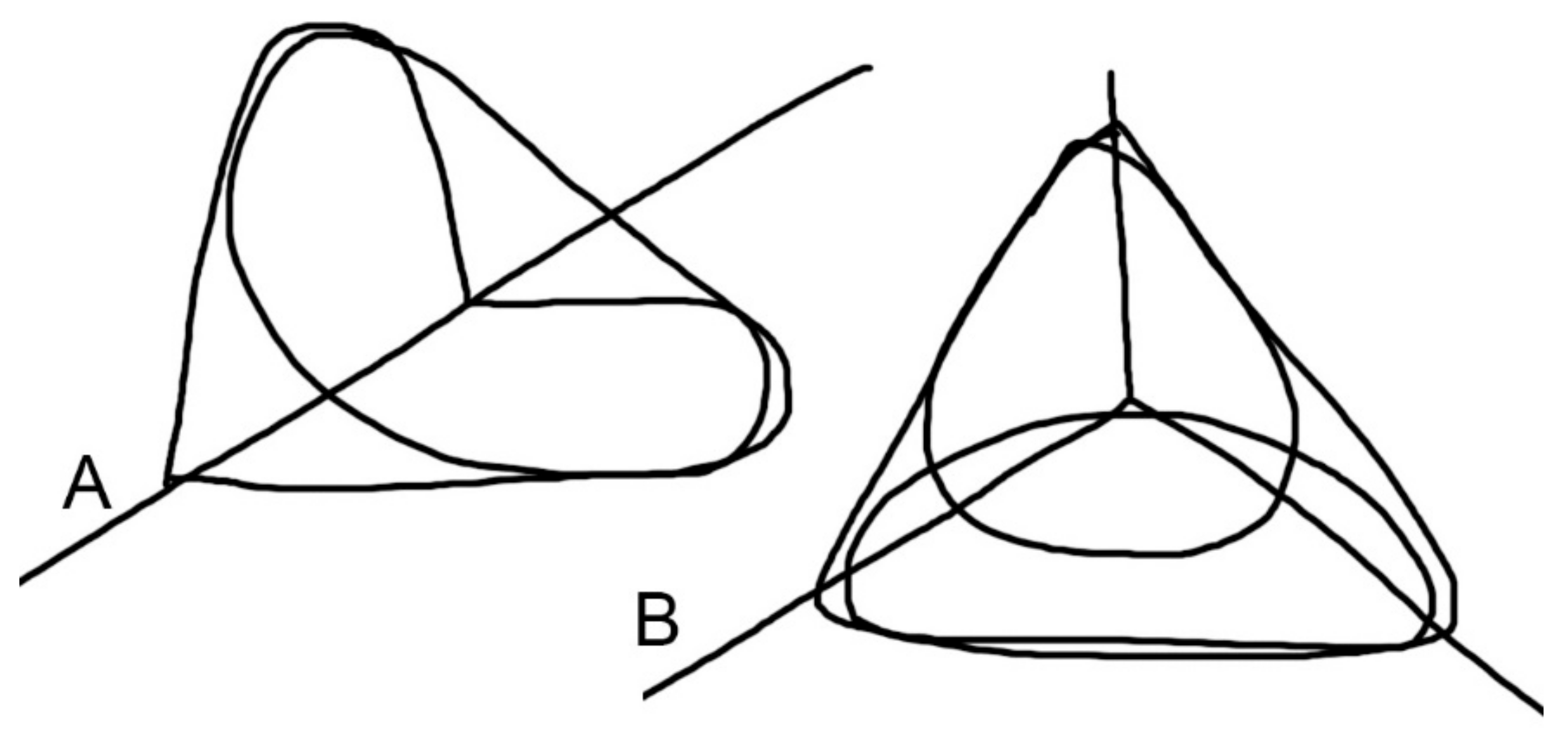

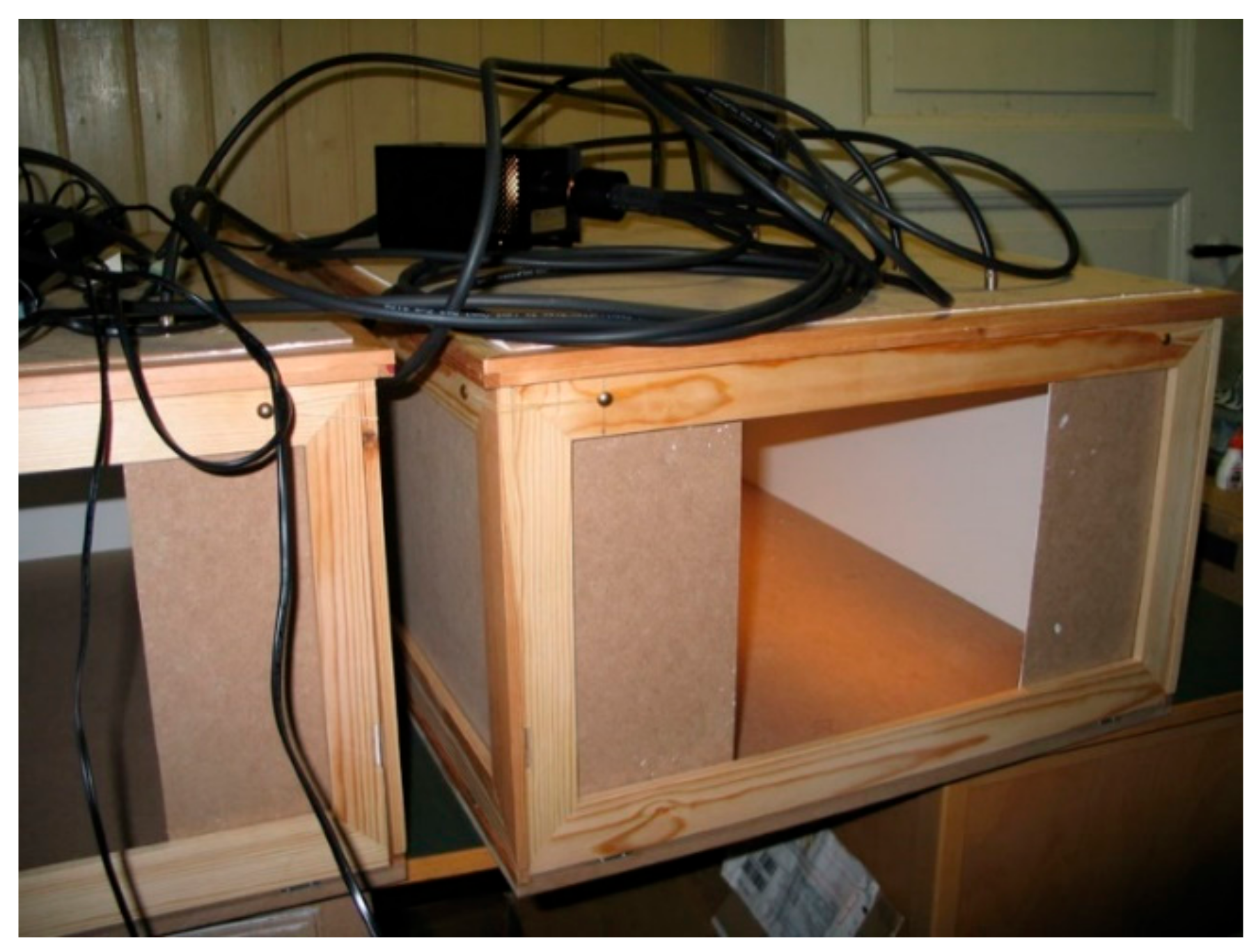



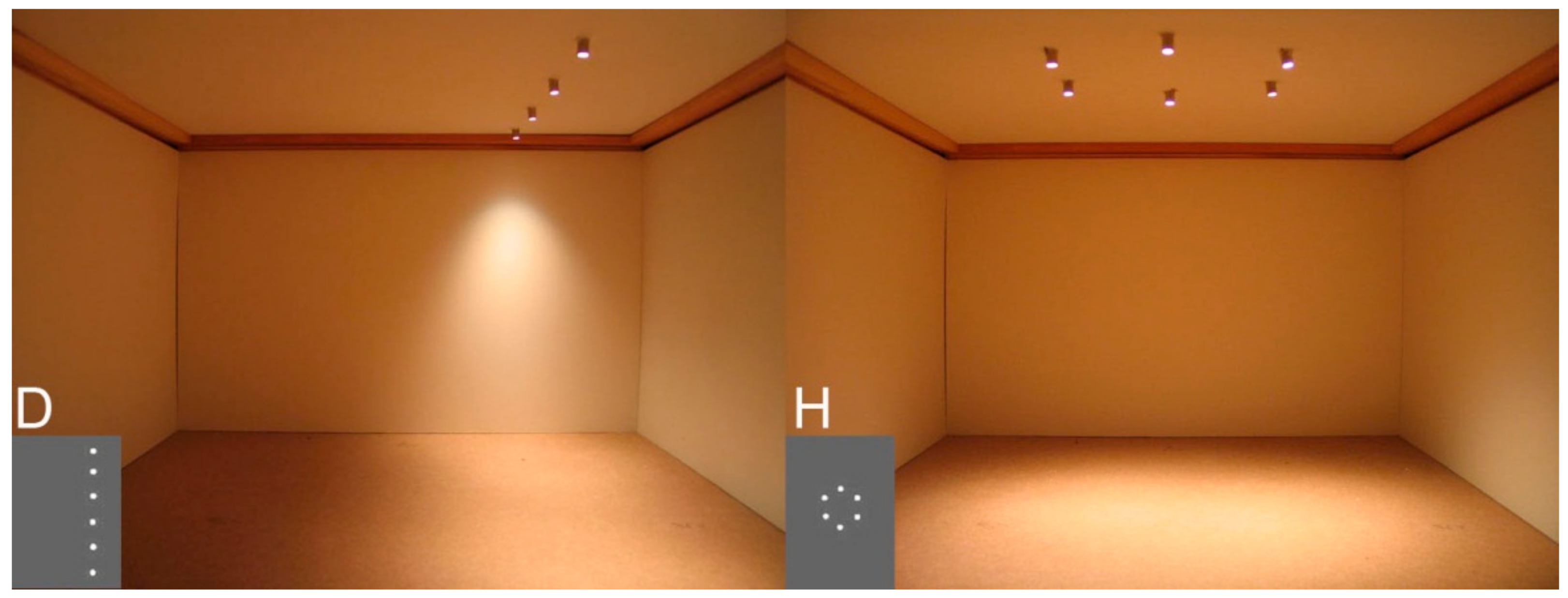
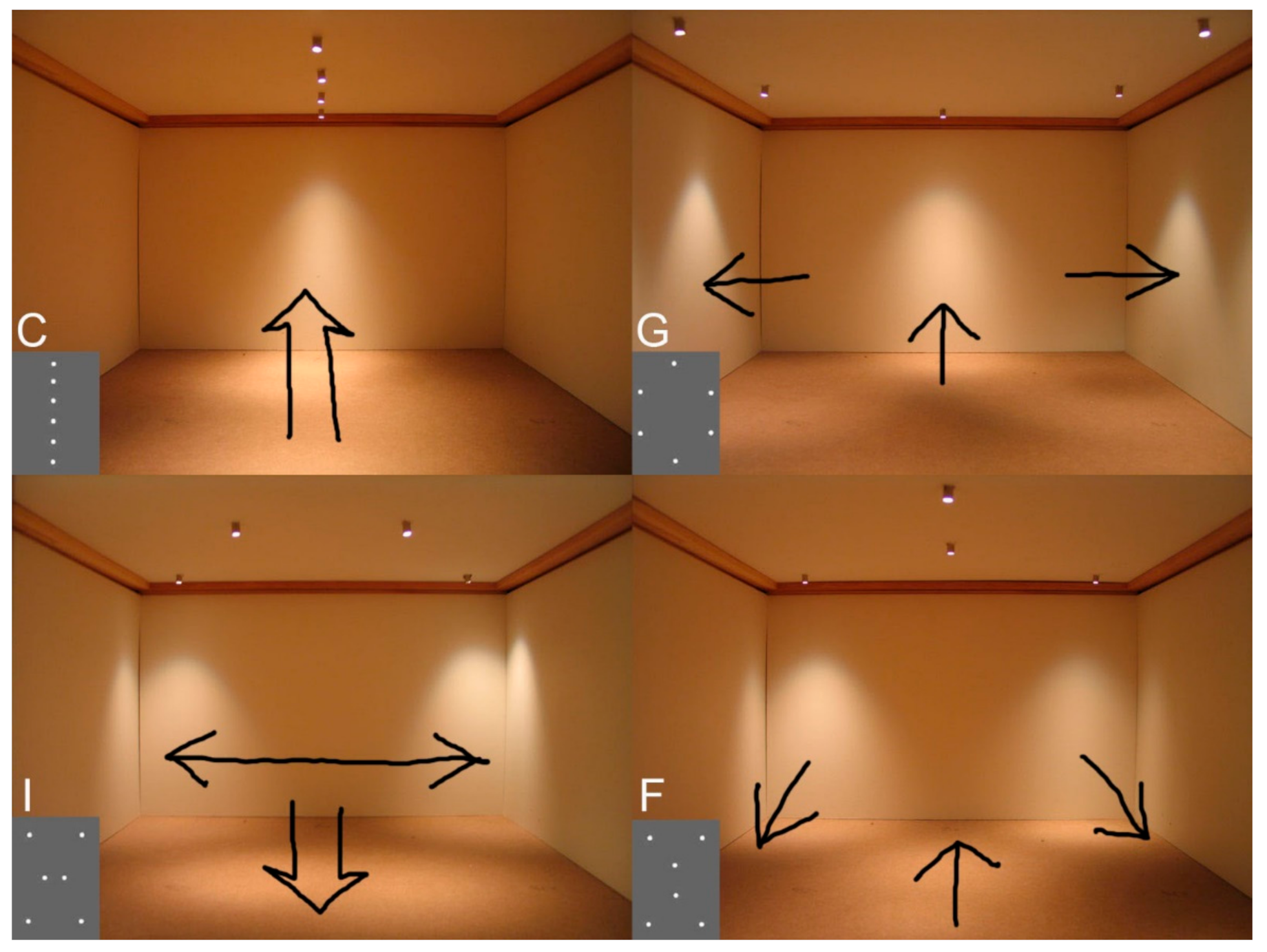
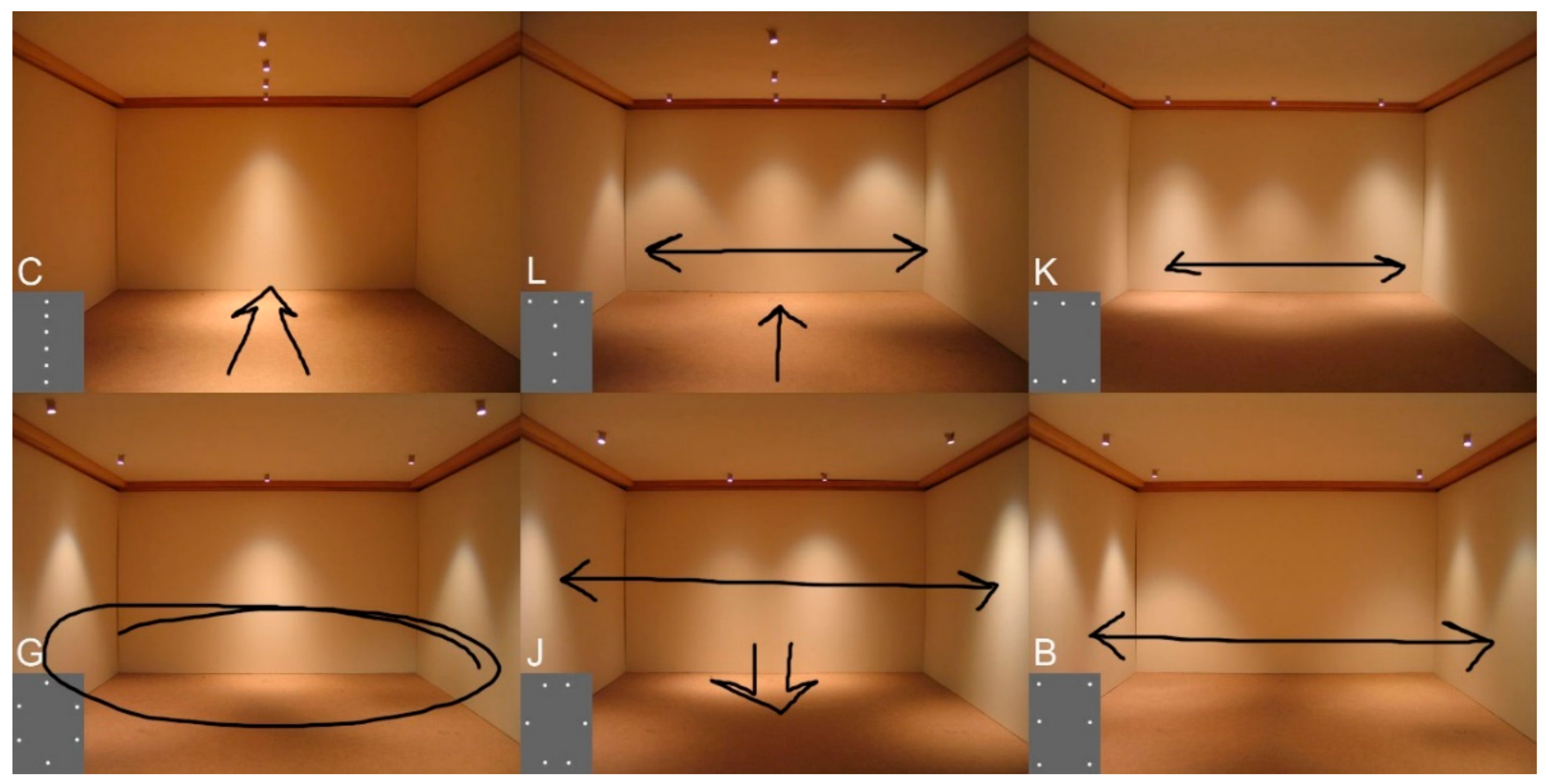
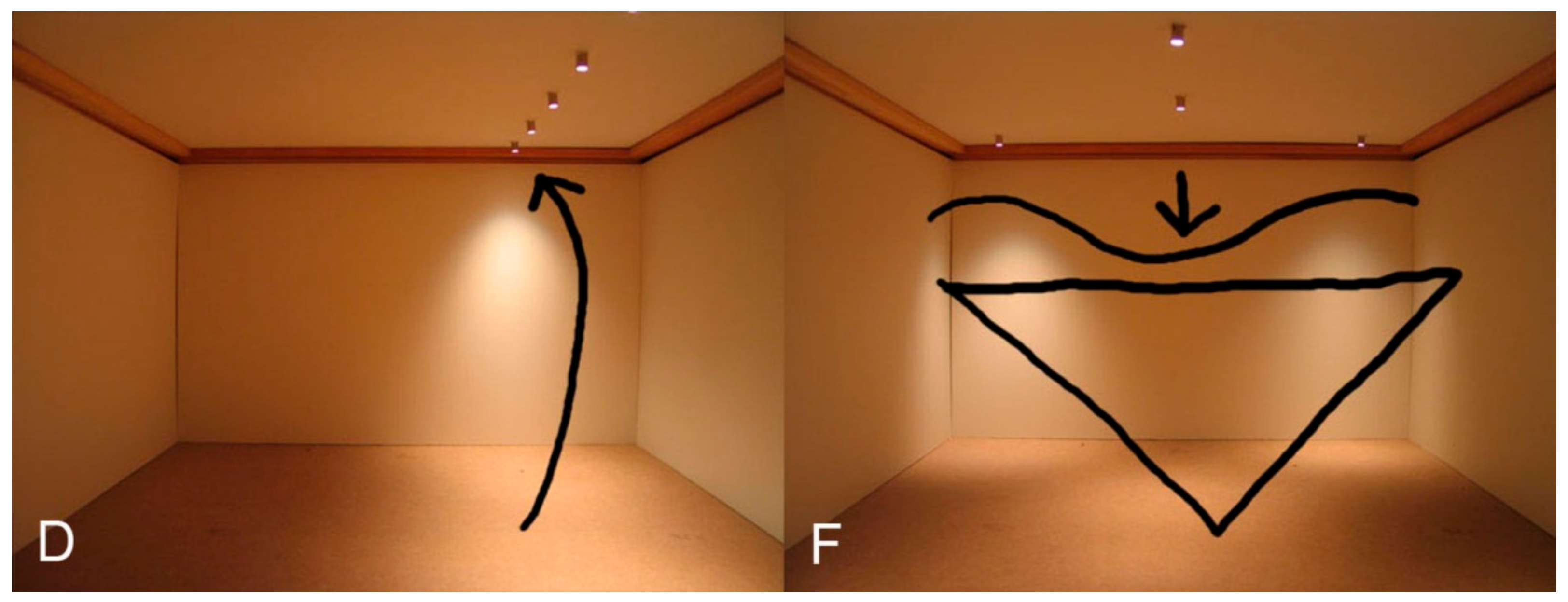
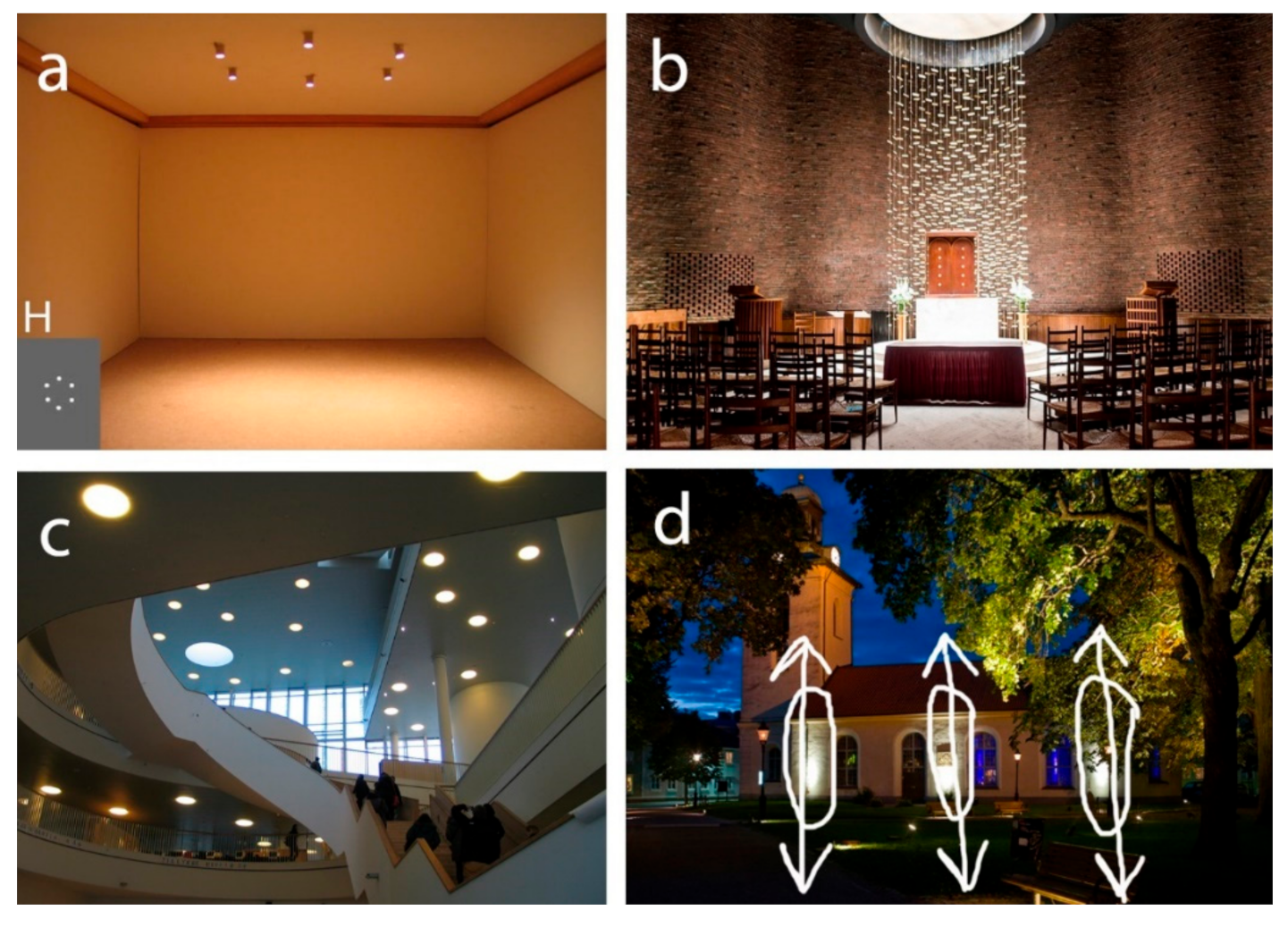
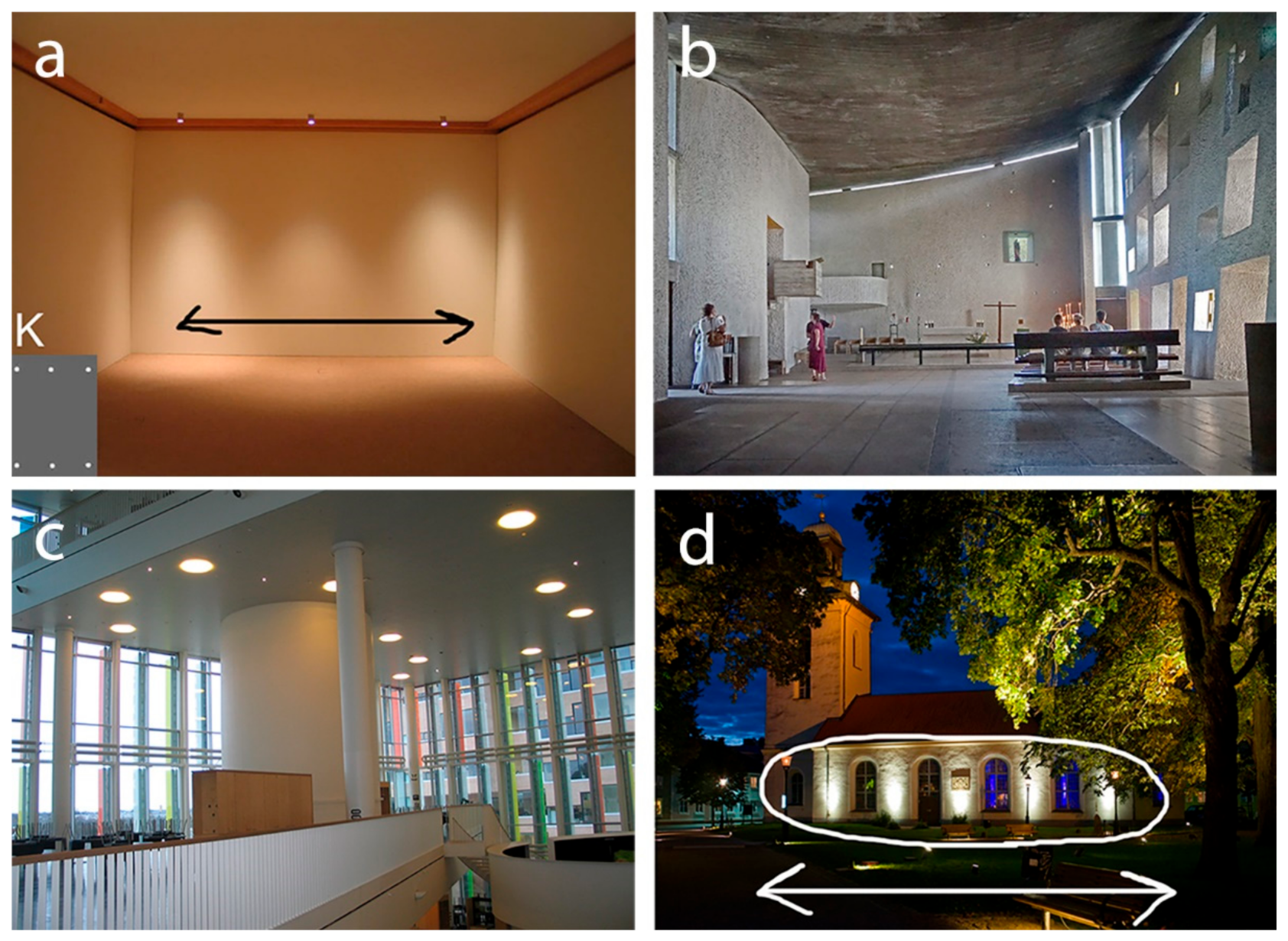


| Spatial Dimensions | Experienced Spatiality | ||||||||
|---|---|---|---|---|---|---|---|---|---|
| Scenarios | High | Low | Wide | Deep | Shallow | Small | Large | Spacious | Enclosed |
| A | |||||||||
| B | B | B | B | B | |||||
| C | C | ||||||||
| D | D | D | D | ||||||
| E | |||||||||
| F | F | F | F | F | |||||
| G | G | G | G | G | |||||
| H | H | H | H | ||||||
| I | I | ||||||||
| J | J | J | |||||||
| K | (K) | ||||||||
| L | L | L | L | ||||||
| Patterns | Light Zones | Lit Walls | Spatial Coherence | |||||||
|---|---|---|---|---|---|---|---|---|---|---|
| Scenarios | Ver. | Hor. | Sep. (a) | Com. (b–c) | Inner | Wall | Yes | No | Order | Conf. |
| A | A | |||||||||
| B | B | B | B | B | ||||||
| C | C | C | ||||||||
| D | D | D | ||||||||
| E | E | |||||||||
| F | F | F | F | |||||||
| G | G | G | G | G | G | |||||
| H | H | |||||||||
| I | I | I | I | I | ||||||
| J | J | J | J | |||||||
| K | K | K | K | |||||||
| L | L | L | L | L | ||||||
Publisher’s Note: MDPI stays neutral with regard to jurisdictional claims in published maps and institutional affiliations. |
© 2021 by the authors. Licensee MDPI, Basel, Switzerland. This article is an open access article distributed under the terms and conditions of the Creative Commons Attribution (CC BY) license (https://creativecommons.org/licenses/by/4.0/).
Share and Cite
Wänström Lindh, U.; Billger, M. Light Distribution and Perceived Spaciousness: Light Patterns in Scale Models. Sustainability 2021, 13, 12424. https://doi.org/10.3390/su132212424
Wänström Lindh U, Billger M. Light Distribution and Perceived Spaciousness: Light Patterns in Scale Models. Sustainability. 2021; 13(22):12424. https://doi.org/10.3390/su132212424
Chicago/Turabian StyleWänström Lindh, Ulrika, and Monica Billger. 2021. "Light Distribution and Perceived Spaciousness: Light Patterns in Scale Models" Sustainability 13, no. 22: 12424. https://doi.org/10.3390/su132212424
APA StyleWänström Lindh, U., & Billger, M. (2021). Light Distribution and Perceived Spaciousness: Light Patterns in Scale Models. Sustainability, 13(22), 12424. https://doi.org/10.3390/su132212424






